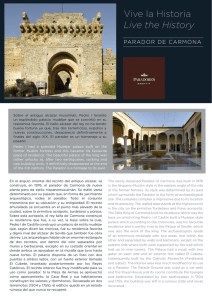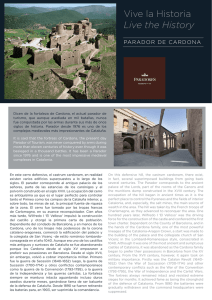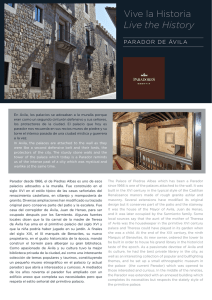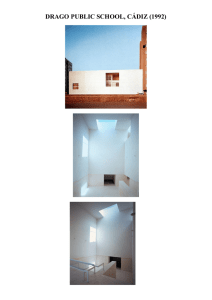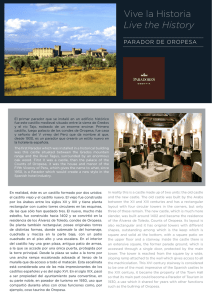Folleto Vive la Historia. Parador de Alarcón
Anuncio
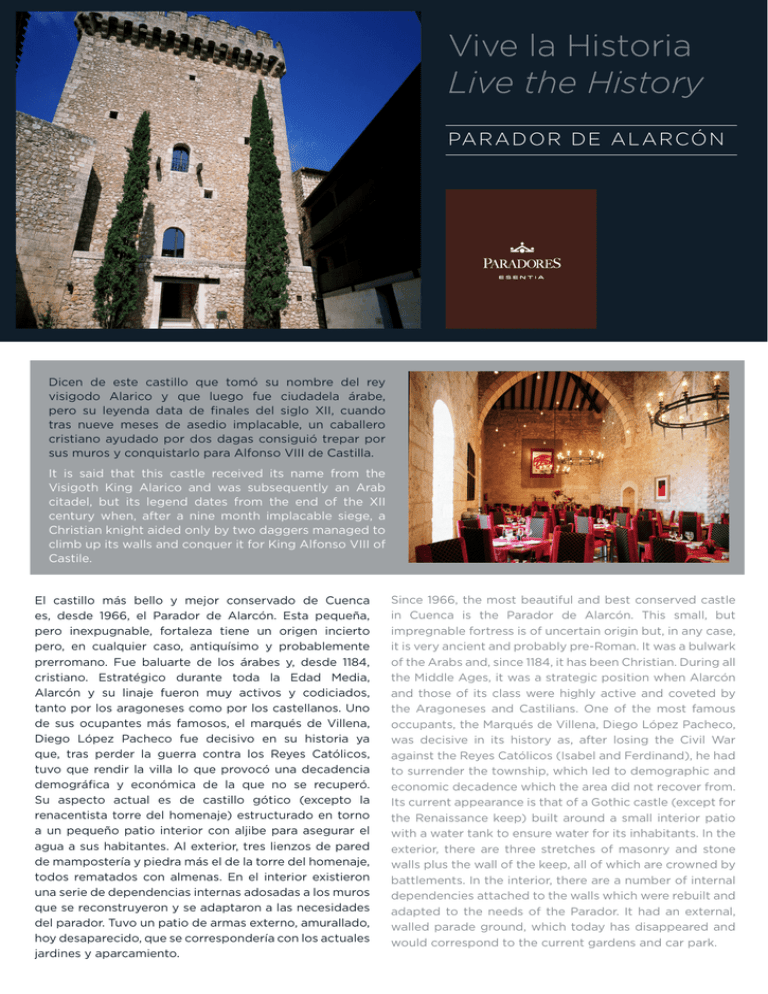
Vive la Historia Live the History PARADOR DE ALARCÓN Dicen de este castillo que tomó su nombre del rey visigodo Alarico y que luego fue ciudadela árabe, pero su leyenda data de finales del siglo XII, cuando tras nueve meses de asedio implacable, un caballero cristiano ayudado por dos dagas consiguió trepar por sus muros y conquistarlo para Alfonso VIII de Castilla. It is said that this castle received its name from the Visigoth King Alarico and was subsequently an Arab citadel, but its legend dates from the end of the XII century when, after a nine month implacable siege, a Christian knight aided only by two daggers managed to climb up its walls and conquer it for King Alfonso VIII of Castile. El castillo más bello y mejor conservado de Cuenca es, desde 1966, el Parador de Alarcón. Esta pequeña, pero inexpugnable, fortaleza tiene un origen incierto pero, en cualquier caso, antiquísimo y probablemente prerromano. Fue baluarte de los árabes y, desde 1184, cristiano. Estratégico durante toda la Edad Media, Alarcón y su linaje fueron muy activos y codiciados, tanto por los aragoneses como por los castellanos. Uno de sus ocupantes más famosos, el marqués de Villena, Diego López Pacheco fue decisivo en su historia ya que, tras perder la guerra contra los Reyes Católicos, tuvo que rendir la villa lo que provocó una decadencia demográfica y económica de la que no se recuperó. Su aspecto actual es de castillo gótico (excepto la renacentista torre del homenaje) estructurado en torno a un pequeño patio interior con aljibe para asegurar el agua a sus habitantes. Al exterior, tres lienzos de pared de mampostería y piedra más el de la torre del homenaje, todos rematados con almenas. En el interior existieron una serie de dependencias internas adosadas a los muros que se reconstruyeron y se adaptaron a las necesidades del parador. Tuvo un patio de armas externo, amurallado, hoy desaparecido, que se correspondería con los actuales jardines y aparcamiento. Since 1966, the most beautiful and best conserved castle in Cuenca is the Parador de Alarcón. This small, but impregnable fortress is of uncertain origin but, in any case, it is very ancient and probably pre-Roman. It was a bulwark of the Arabs and, since 1184, it has been Christian. During all the Middle Ages, it was a strategic position when Alarcón and those of its class were highly active and coveted by the Aragoneses and Castilians. One of the most famous occupants, the Marqués de Villena, Diego López Pacheco, was decisive in its history as, after losing the Civil War against the Reyes Católicos (Isabel and Ferdinand), he had to surrender the township, which led to demographic and economic decadence which the area did not recover from. Its current appearance is that of a Gothic castle (except for the Renaissance keep) built around a small interior patio with a water tank to ensure water for its inhabitants. In the exterior, there are three stretches of masonry and stone walls plus the wall of the keep, all of which are crowned by battlements. In the interior, there are a number of internal dependencies attached to the walls which were rebuilt and adapted to the needs of the Parador. It had an external, walled parade ground, which today has disappeared and would correspond to the current gardens and car park. DON JUAN MANUEL Y SU CONDE LUCANOR Uno de los dueños del castillo fue Don Juan Manuel (1282-1348), hombre de armas, política y letras. Influyente consejero de reyes, protagonista de intrigas entre los reinos peninsulares y señor feudal. Pasó a la historia por su célebre libro “El Conde Lucanor”, un libro de cuentos provechosos “para enseñar deleitando”. Señor de Alarcón desde 1305, reconstruyó el castillo en el que pasó largas temporadas y donde pudo escribir algunas de sus mejores obras como el perdido “Libro de la Caballería” o “El Conde Lucanor” o “Libro de Patronio”. Por ambos está considerado como el máximo exponente de la prosa castellana del siglo XIV. Emparentado con la realeza castellana, se relacionó con la aragonesa a través de su matrimonio y uno de sus nietos llegó a ser rey de Castilla, Juan I y otro, Fernando, de Portugal. Las luchas dinásticas de la España de la época y sus posesiones territoriales, entre Castilla y Aragón, marcaron su vida e hicieron de él una pieza importante en las relaciones de poder peninsulares. Hábil político, en ocasiones fue intermediario entre ambas coronas y, en otras astuto, intrigante, pero en cualquier caso un personaje clave en la compleja historia española de la Baja Edad Media. DON JUAN MANUEL AND HIS COUNT LUCANOR One of the owners of the castle was Don Juan Manuel (1282-1348), a man of arms, politics and letters. An influential councillor of kings, the protagonist of intrigue involving the peninsular kingdoms and feudal lord, he passed into history due to his famous book “Count Lucanor”, a book of helpful stories “to teach through enjoyment”. He was the Lord of Alarcón from 1305 and rebuilt the castle in which he spent long periods of time and where he may have written some of his best works such as the lost “Book of Chivalry” or “Count Lucanor” and the “Book of Patronio”. Due to both of these, he is considered to be the finest exponent of Castilian prose writing in the XIV century. Related to Castilian royalty, he became related to the Aragonese royalty through his marriage and one of his grandchildren became Juan I, King of Castile, and another, Fernando, became King of Portugal. The dynastic clashes in the Spain of the epoch and its territorial possessions involving Castile and Aragon affected his life and made him an important player in the peninsular power relationships. A skilful politician, on occasions he was an intermediary between both crowns or, on other occasions, he was an astute intriguer. However, in any case, he was a key player in the complex Spanish history of the Low Middle Ages. UNA FORTALEZA INEXPUGNABLE Al Parador de Alarcón se accede a través de un angosto istmo que hoy es una estrecha carretera. Tras las tres puertas y fosos se alza el castillo de planta trapezoidal que se adapta a la roca sobre la que se construyó. Su sistema defensivo está basado en dos atalayas situadas fuera del istmo a modo de pequeños castillos vigía (torres del Alarconcillo y del Cañavate) más las tres murallas concéntricas. AN IMPREGNABLE FORTRESS The Parador is accessed through a narrow isthmus which is now a narrow roadway. Behind the three doors and moats rises the castle on a trapezoid ground plan which is adapted to the rock on which it is built. Its defensive system is based on two watchtowers located outside the isthmus in the form of two small lookout castles (the towers of the Alarconcillo and of the Cañavate) plus the three concentric walls. TAMBIÉN LE GUSTARÁ: YOU WILL ALSO LIKE THE FOLLOWING: Ruta a pie por la villa de Alarcón. The route on foot through the town of Alarcón Ruta de los otros castillos de Cuenca: Garcimuñoz y Belmonte. The route of the other castles of Cuenca: Garcimuñoz and Belmonte Categoría: Castillo Fecha: 1966 Arquitecto: Manuel Sainz de Vicuña y Ignacio Gárate BIC: Monumento Category: Castle Date: 1966 Architect: Manuel Sainz de Vicuña and Ignacio Gárate BIC (Property of Cultural Interest): Monument
